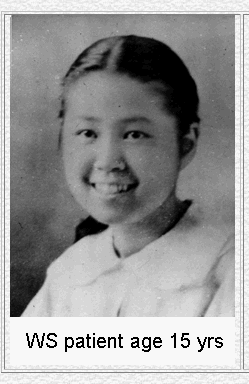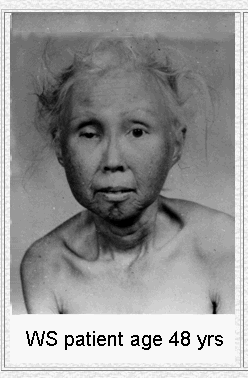Werner Syndrome-Loss of function of the RecQ helicase
I. DNA Helicase
DNA Helicases are enzymatic proteins responsible for many cellular processes including DNA replication, transcription, translation, recombination, DNA repair, and ribosome biogenesis. (Wikipedia). Using energy from ATP hydrolysis, this protein moves down the nucleic acid phosphodiester backbone of a strand of double stranded DNA (or RNA in some instances) separating the base pairs to make the DNA strands accessible to other proteins. (Genomes 2).

There are many different 'superfamilies' of helicases, one of which includes the RecQ helicase family which functions in genome maintance.(Brosh 2002). Within this family is the WRN protein and it is the loss of function of this RecQ helicase protein that results in the genetic disorder Werner syndrome. (Sidorova 2008).
II. Werner Syndrome
Werner syndrome (WS) is an autosomal recessive genetic disorder of chromosome 8 associated with premature aging.(Swanson et al. 2004).


(International Registry of Werner Syndome)
WS effects one of out one million individuals and it can occur in both males and females. (About.com). The onset of symptoms in WS patients begins at puberty. Individuals with WS are at high risk of developing age-associated diseases such as osteoporosis, type II diabetes mellitus, cancer and cardiovascular disease, the latter two being the main causes of death in WS patients.(Swanson et al. 2004). Aside from the life threatening diseases, there are other features of this syndrome that characterize those with WS. These include graying and loss of hair, short stature, a high pitched voice, cataracts, thickening of the skin, and other typical signs of aging. (Werner Syndrome).
The cellular roles of the WRN protein have been associated with telomere maintenance, DNA repair, homologous recombination, and other processes similar to that of most helicases.(Sidorova 2008). More specifically, the WRN RecQ helicase possess 3' to 5' exonuclease activity as well as 3' to 5' helicase activity and it is thought to be the loss of both of these catalytic acivities that lead to the WS cellular phenotype.(Swanson et al. 2004).


The fold structure of the WRN exonuclease domain, with alpha helices (blue), beta strands (green), and loops (brown). The active-site amino-acid residues are at centre (yellow), showing oxygen atoms (red) and two manganese ions (magenta). (The Human Genome).
III. Diagnosis and Treatments
The diagnosis of WS can be made when examining the individual's physical characteristics. The physical symptoms associated with WS are quite noticeable once puberty has occured. Another possible way to distinguish between an individual with WS with a healthy individual is to look at blood samples. In blood samples from Werner syndrome patients, large insertions or deletions in the DNA polymerase beta gene on the 8th chromosome were identified.(OMIM).
Currently, there are no cures or significant treatments for those diagnosed with Werner Syndrome.
Comments (1)
Christopher Korey said
at 3:12 pm on Apr 6, 2009
Outline looks great--you are covering all the relevant information. Remember to be concise about each subsection in the text. Each section should be a clean description of the protein and then linking out to more information. Transform the outline into sections by using the horizontal bar to separate each section. Remember to reference.
You don't have permission to comment on this page.